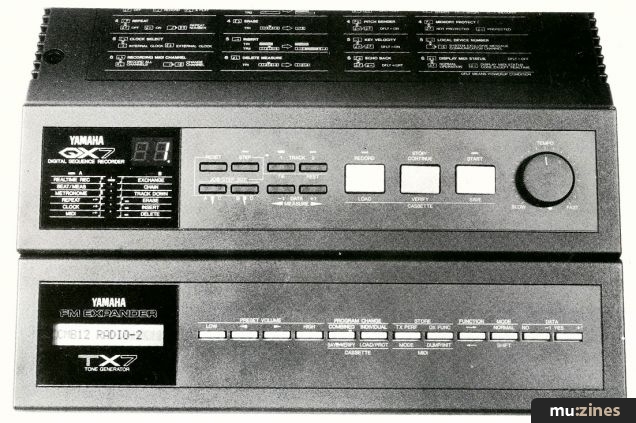Magazine Archive
Home -> Magazines -> Issues -> Articles in this issue -> View
Yamaha QX21 MIDI Sequencer | |
Article from Electronics & Music Maker, April 1986 | |
The Nippon Gakki people have updated their budget QX7 MIDI Recorder by giving it a few extra facilities - and slashing its selling price in half. Simon Trask investigates.

The budget end of the hi-tech musical instrument market is becoming more and more competitive as the weeks go by, and it must be giving the marketing people a headache or two. Tough decisions have to be made as to which facilities can be left out, and which must be included at all costs. However, with their latest sequencer Yamaha have taken the unusual step of not leaving anything out at all. Not as far as I can see, anyway.
Truth to tell, the new QX21 is really just the QX7 (reviewed in E&MM April '85) with a few small alterations. The only appreciable differences are a slight change to the 21's MIDI data filtering facilities, the inclusion of a 'free memory' display (on a scale of 0-99) and the addition of a channel delete facility. The latter is a definite improvement, and it's tempting to wonder why the QX7 wasn't the QX21 in the first place, if you see what I mean.
Price alone suggests the QX21 is aimed fair and square at Casio's SZ1 sequencer (reviewed in E&MM September '85). On the facilities front it compares very favourably with the Casio, allowing more flexible editing and having more than double the memory (approximately 6000 notes with velocity, 8100 notes without). Although the 21 is organised as a two-track sequencer, you can in fact record on all 16 MIDI channels (though you're limited to 16 notes per track, so you can't do endless overdubbing), whereas the SZ1 limits you to a maximum of four different MIDI channels, even with bouncing down.
Recording on the QX21 (which can be in real or step time - polyphonic in both cases) is always on track 1. You then transfer your recorded data to track 2, record again on track 1, and overdub the new recording onto track 2 - effectively building up more than two tracks. With the QX7, however, you couldn't isolate different parts once you'd overdubbed; this is where the 21's channel deletion is valuable, as it allows you to erase parts associated with a particular MIDI channel. Thus if you feel that a particular part is too busy within the overall texture of a piece, you can erase it without having to erase everything else as well.
However, it's a pity that Yamaha haven't taken this channel isolation principle further; a channel solo facility and some channel-specific editing would have enhanced the sequencer's usefulness a fair bit.
What else is of note? Well, the temporary storage buffer is useful for, among other things, being able to retrieve a track after a disastrous attempt at quantisation. Recording, playback and editing can begin from any bar, which is handy. And editing facilities include inserting and deleting individual bars, chaining track 1 data onto the end of track 2, and inserting track 1 data anywhere into track 2. The QX21 is measure-based, with bar-lengths ranging from 1/4 to 16/4 or 1/8 to 16/8.
Interfacing is strictly MIDI-only, with MIDI In, Out and Thru all resident on the back panel. It's still a pity the MIDI Thru can't be switched to a MIDI Out, though: one MIDI Out simply isn't enough for more demanding applications, though Yamaha would no doubt be pleased if you bought their YMC10 MIDI Thru box.
Sequence data can be stored to tape, but like its predecessor, the QX21 can also transmit and receive sequence data via MIDI System Exclusive coding. This has the advantage of being much quicker than simply playing the data over MIDI, but don't imagine that you can transfer data to just any old sequencer - life just isn't that straightforward. What you can do is transfer data between QX21 and QX7, which I suppose might come in handy for some people.
It's clear that the QX21 isn't a cut-down version of the QX7. In fact, it adds one or two useful features to the original machine. The QX21 is in many ways more flexible than the Casio with which it competes - and has more than double the note storage capacity. Maybe it's not quite as straightforward to use as the SZ1, but if you're after a dedicated sequencer, the QX21 has some useful features, and at its 'new' price, represents something of a bargain.
Price RRP £259 including VAT
More from Yamaha-Kemble, (Contact Details)
Featuring related gear
Hi-Tech Xpansion
(EMM Apr 85)
Yamaha TX7 expander/QX7 sequencer
(12T May 85)
Browse category: Sequencer > Yamaha
Publisher: Electronics & Music Maker - Music Maker Publications (UK), Future Publishing.
The current copyright owner/s of this content may differ from the originally published copyright notice.
More details on copyright ownership...
Review by Simon Trask
Previous article in this issue:
Next article in this issue:
Help Support The Things You Love
mu:zines is the result of thousands of hours of effort, and will require many thousands more going forward to reach our goals of getting all this content online.
If you value this resource, you can support this project - it really helps!
Donations for April 2024
Issues donated this month: 0
New issues that have been donated or scanned for us this month.
Funds donated this month: £7.00
All donations and support are gratefully appreciated - thank you.
Magazines Needed - Can You Help?
Do you have any of these magazine issues?
If so, and you can donate, lend or scan them to help complete our archive, please get in touch via the Contribute page - thanks!








